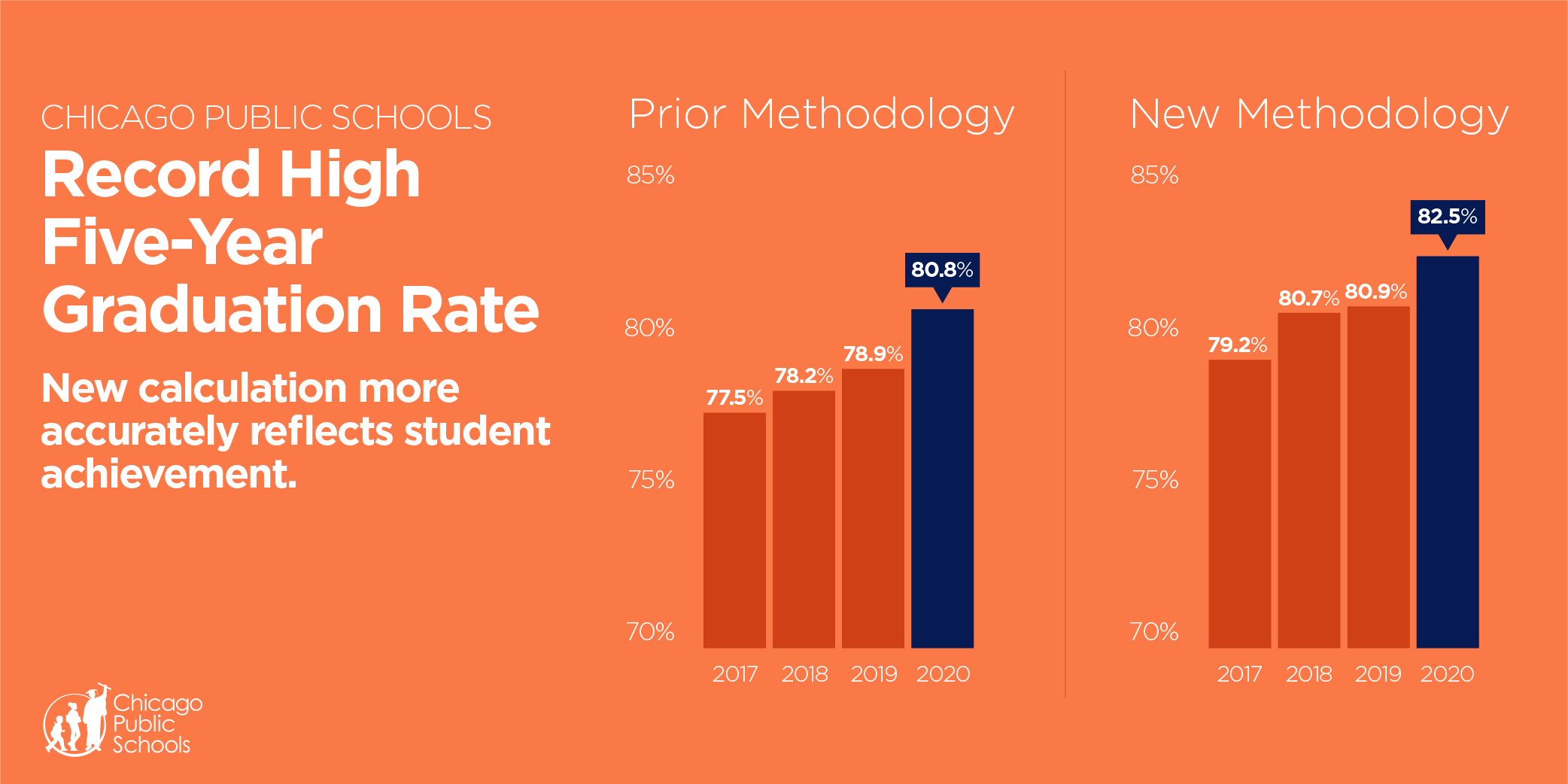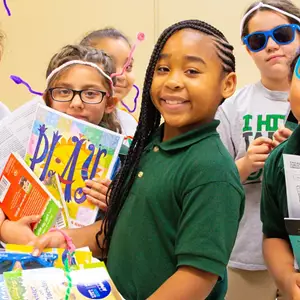04 September 2020
Mayor Lightfoot and Chicago Public Schools Announce Record-High Graduation Rate
Record High Graduation Rate of 82.5 Percent Driven by Academic Progress by Latinx Students; District Implements Changes to Calculation Based on Principal Feedback to Ensure Greater Accuracy

CHICAGO - Mayor Lori E. Lightfoot and Chicago Public Schools (CPS) CEO Jackson announced today that CPS students have set a new record high 5-year graduation rate of 82.5 percent (up from 80.9 in 2019 using the new methodology), which was propelled by the academic progress of Latinx students. Over the last decade, Chicago’s graduation rate has risen nearly 27 percentage points from 2010 when only 55.8 percent of CPS students earned a diploma.
“Despite the many challenges they faced, our students still managed to take another huge leap forward in their journey toward achievement and success thanks to the shared efforts of our CPS families, teachers, principals, and staff,” said Mayor Lightfoot. “This record graduation rate isn’t just a statistic, it represents a revolution in how we value education in our city, and how we support our students’ futures. Our charge now is to keep this success going as we embark on this unprecedented school year. To every CPS student and parent, I promise you this: We are not sitting this year out. No matter the obstacles ahead, we will continue our march forward until every one of Chicago’s young people finishes high school with a diploma in hand and a plan on what they’re going to do next.”
“As a district we have made incredible progress over the past decade by transforming the experiences of our high school students through strengthening our focus on programming, social-emotional support and counseling,” said CPS CEO Dr. Janice K. Jackson. “Nothing has driven this success more than the hard work of our students, counselors, educators, and school leaders. While critical work remains ahead, we are immensely proud of our students and their accomplishments as they continue to make our city proud.”
Major Improvements Among Latinx and African American Students
The racial groups making up the largest percentage of CPS students, Latinx students and African American students, both saw significant increases over 2019 with a 2.2 percentage point increase (from 82.3 percent to 84.5 percent) for Latinx students and 1.2 percentage point increase (from 76.8 percent to 78 percent) for African American students. Since 2017, the percentage of African American students earning a diploma has increased by 4 percentage points, which is the highest increase among all major racial groups in the district during that time period.
Improvements in the graduation rate at neighborhood schools, charter schools, and selective enrollment schools also contributed to the district’s record-high graduation rate.
Diverse CPS Schools Across Chicago Achieve Highest Graduation Rates
Schools with the highest 5-year graduation rates in 2020 represent a diverse group of schools, with multiple school types and geographic regions represented, including selective enrollment, neighborhood open enrollment schools, and a charter school. The top ten schools with the highest 5-year graduation rates are: Whitney Young, Northside College Prep, Walter Payton, Lane Tech, Jones College Prep, Hancock High School, Perspectives - Joslin High School, Back of the Yards, Westinghouse, and Williams High School.
Methodology Changes to More Accurately Capture Student Achievement
In order to capture a more accurate graduation calculation, the district implemented several changes to the graduation rate based on principal feedback that eliminate duplicate students in freshman cohorts, ensure students are included in the correct cohort, allow diverse learners who remain in school after meeting graduation requirements and earning a diploma to count in a school’s graduation rate, and more. Since 2015, the district has utilized a conservative methodology that has remained relatively unchanged, and the improvements are a result of years of principal feedback that identified necessary modifications to more accurately determine the district’s graduation rate. Detailed descriptions of methodology changes can be found here.
“CPS and the Consortium have been working together to adopt a methodology for reporting graduation rates that is more consistent between the organizations,” said Jenny Nagaoka, Deputy Director of the UChicago Consortium on School Research. “These changes more effectively use the available data and provide a more accurate determination of which students should be included in the graduation rate and counted as graduates.”
The district re-calculated prior years’ graduation rate to provide an apples-to-apples comparison and, under both methodologies, a clear pattern of sustained district-wide improvement emerges. The steady improvement in graduation rates is consistent with years of Freshmen On-Track data, which serves as a predictor of graduation, and various research reports from the UChicago Consortium on School Research. A comparison of the prior methodology and the new methodology can be found below:
Methodology

Prior Methodology v. New Methodology
One Year Drop-Out Rate
This year, the district also achieved the lowest one-year dropout rate on record with a rate of 5.6 percent, which is a decrease from 6.0 percent in 2019. The one-year dropout rate measures the percent of students who drop out over the course of a given year, as opposed to the cohort dropout rate, which reflects multiple years and aligns with the annual cohort graduation rate.
These improvements were largely driven by African American students, who had a decrease of 0.9 percentage points since 2019 (from 8.1 percent to 7.2 percent in 2020), with African American males seeing a decrease of one percentage point (from 9.0 percent to 8.0 percent in 2020), the largest of any other demographic group. Encouraging trends were also seen among diverse learners, who had a 1.1 percentage point decrease compared to last year (from 7.7 percent to 6.6 percent in 2020).
As opposed to the cohort graduation rate and cohort dropout rate, which are multi-year metrics of the same group of students, one-year dropout is used to gather an understanding of how high schools are supporting students and working to prevent students from dropping out over the course of a single school year.
While the district’s one-year dropout methodology is the most accurate measurement available and the results are consistent with multi-year trends, the COVID-19 pandemic created challenges for schools on reporting this particular metric, specifically as it pertains to students who may have been disengaged during the remote learning period and students who have transferred but the school has been unable to verify due to extended school closure nationwide. In a typical year, a student who stopped attending school would have been unenrolled and considered dropped out, but it is difficult for schools to delineate between disengaged students and students who dropped out in a remote learning setting. Additionally, there was a large increase in unverified transfers, which are counted in the numerator of this metric and labeled “dropouts” even though they may be engaged at another school. The district believes that these two competing factors — delineating between disengaged students and dropouts, which potentially lead to an undercount of dropouts and an over-reporting of unverified transfers (which are considered dropouts) — ultimately offset each other. Students with whom the district lost contact with during remote learning who do not re-enroll in the fall will count against the SY21 metric.
These factors do not impact the cohort graduation rate for a variety of reasons. First, this is a measurement of data of a cohort of students over the course of five years, and it is very uncommon for an active student to drop out in the final quarter of their senior year. In order to be included in the calculation, every student had to meet rigorous graduation requirements, with the district only waiving requirements for students who have not yet met them due to certain courses or exams not being available.
Building on Success During Remote and Traditional in-Person Learning
In order to continue building upon the district’s progress, CPS continues to prioritize equity-centered initiatives and investments to build upon record-breaking academic improvements.
“While our graduation rate has seen remarkable growth and continues to rise, we will continue to acknowledge the opportunity gap and work to ensure our most vulnerable students receive the support they need,” said CPS Chief Education Officer LaTanya D. McDade. “This fall, we will be supporting our students through high-quality remote learning and digital resources, and we will continue to work tirelessly to ensure that every student has access to high-quality instruction and programming that prepares them for postsecondary success.”
Critical Remote Learning Initiatives:
- Devices: CPS has committed to providing a device to every student who needs one. Last school year, the district distributed more than 128,000 devices. In anticipation of the start of the new school year, the district has distributed more than 12,000 devices and device distribution remains ongoing.
- Connectivity: Eligible CPS families can receive high-speed internet in their homes at no cost for up to four years through the district’s Chicago Connected program. More than 24,000 students have been connected through the program, which is serving as a model for expanding free internet access in other large cities across the country.
Critical Initiatives to Support Learning in All Settings:
- Office of Equity: The district’s equity office is supporting all matters involving equity of access and learning to help address the opportunity gap.
- Hiring Additional Support Staff: The district has committed to provide a nurse and social worker in every school by the 2023-24 school, and the 2020-21 school year marks record high staffing levels for nurses, social workers and special education case managers.
- Curriculum Equity Initiative: The Curriculum Equity Initiative creates a standards-aligned, culturally relevant library of teacher resources to ensure that students in every part of Chicago can benefit from a high-quality curriculum and instructional resources. As the district works toward a full release in July 2021, the district has released preliminary supplemental resources a year early to ensure our educators have grade-level digital content available for the start of the school year.
- Increasing Access to College-Level Programming: The district continues to invest in programs such as IB, STEM, Fine & Performing Arts, dual credit and dual enrollment programming to increase opportunities for students to earn early college and career credentials.
- Options School Redesign: The district established a partnership with the University of Chicago Education Labs to evaluate how Options Schools can provide the best possible educational experience and social-emotional support to the city’s most vulnerable students.
- High School Resource Hub: High school teachers and administrators participate in professional learning through a tiered system designed to ensure resources and support are equitably distributed across the district. All high schools engage in learning aligned to the district’s instructional priorities that emphasize the importance of relationships and relevance in keeping high school students engaged in meaningful learning.
- In-Class Math Tutoring: The district continues to invest in this intervention for at-risk students in grades 9 and 10 which has shown to have a positive impact on Freshman On Track, Sophomore On Track, GPA, and test scores. During remote learning, this partnership has adjusted to ensure students continue to receive this additional support.
- Transitional Math: The district continues to expand access to 12th grade Transitional Math courses as high-quality options for students. Successful completion of any Transitional Math course guarantees placement into a college credit bearing math class at any community college in Illinois. In partnership with the City Colleges of Chicago, the district provides teachers with curriculum and ongoing professional learning to support student learning.
This year marks the highest graduation rate on record, but due to declining enrollment, a slightly smaller number of cohort graduates earned diplomas this year than last year:
By summer 2020, 21,069 students from the 2015-2016 cohort graduated (new methodology).
By summer 2019, 21,282 students from the 2014-2015 cohort graduated.
By summer 2018, 20,717 students from the 2013-2014 cohort graduated.
By summer 2017, 20,525 students from the 2012-2013 cohort graduated.
By summer 2016, 20,438 students from the 2011-2012 cohort graduated.
By summer 2015, 20,316 students from the 2010-2011 cohort graduated.
By summer 2014, 20,232 students from the 2009-2010 cohort graduated.
By summer 2013, 19,906 students from the 2008-2009 cohort graduated.
By summer 2012, 18,577 students from the 2007-2008 cohort graduated.
By summer 2011, 18,446 students from the 2006-2007 cohort graduated.
Chicago Public Schools serves 355,000 students in 638 schools. It is the nation’s third-largest school district.



